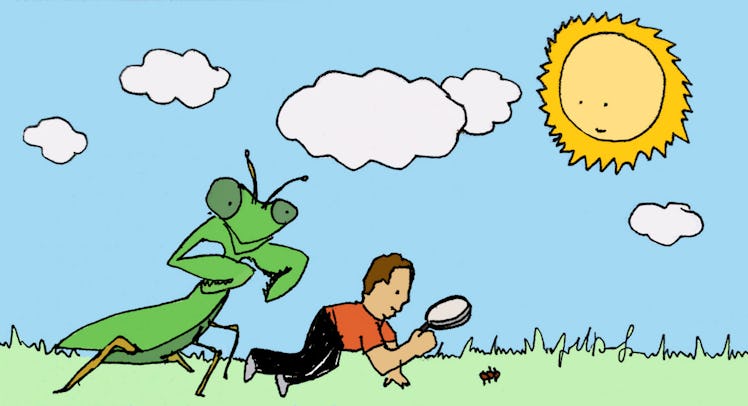‘Bug Hunt’ Is a Scavenger Game That Teaches Kids About Nature
It also teaches them to stop saying "ewwww bugs!" every time they see an insect.

Looking for a good game to bust out at the park or backyard? ‘Bug Hunt’ is a simple scavenger hunt where kids search for real bugs instead of clues or buried ‘fossils.’ It’s designed not only to get children outdoors and observing nature, but also to show them that insects are rarely like the B-movie villains they’re depicted as on TV or in the movies. As activities for kids go, it’s one of the best at combining education and fun.
Many kids develop irrational fears of bugs early, or are taught that bugs are gross. ‘Bug Hunt’ is an attempt to disabuse them of those notions in a fun, competitive way. It aims to instill curiosity and fascination by showing them that a wide variety of insects are harmless, can be found almost anywhere ⏤ from parks and schools to their own backyard ⏤ and are necessary for life to thrive.
Prep Time: 10 minutes
Entertainment Time: 30 to 60 minutesEnergy Expended by Child: Moderate
What You Need:
- A magnifying glass
- A hunting ground: A backyard, garden, or local park
- A notebook and pens for keeping track of what you find and where
- Optional: A field guide to bugs and/or a smartphone
How to Play:
Start by finding a place to look for bugs. Backyard gardens or nearby green spaces are obvious places to start. If you live in a city, the local park is perfect. Once you’re in the ‘field,’ explain the mission and offer some ground rules. Make it clear that they should be finding bugs, not touching them (this will help avoid any potential bites/stings). And let them know that the goal is to find and observe as many bugs as possible. The kid who finds the most wins!
When you’re bug hunting, search as a team and in the same place. This way, you’re the one flipping over logs, stones, and objects, and you can ensure everybody is safe. Start with flowering plants ⏤ they’re essentially insect hotels when in bloom ⏤ before moving to areas of exposed soil, moist dirt, or plant beds covered with wood chips or straw. Don’t forget the grass too! Butterflies, bees, wasps and the like are among the most common finds, but when you look closer, you’ll likely to see an incredible variety of other insects that thrive by blending in ⏤ leafhoppers, aphids, and walking sticks for example. A magnifying glass can be especially useful here, as some insects are just flat-out tiny.
For each bug that you find, have the kids scribble down some details about it, including what it looked like, how many legs/wings it had, where they found it, what it was doing, and what they think it eats. Have them sketch out a quick picture, too. (These are often hilarious.) If you’re having trouble identifying a bug, don’t worry — just snap a photo with a smartphone (or do a quick search), narrow the bug down to a more general group (beetles, ants, bees, etc.), and move on. The object remember is to find many bugs. Don’t get bogged down trying to identify each one on the spot — you can do that later around the computer.
That said, it shouldn’t take long for the game to get crawling. On our most recent bug hunt, we found five varieties of beetles and several different kinds of ants on the asphalt of our driveway alone. And once the kids were out in the yard, and I (carefully) flipped over a log by our fire pit, they were in creepy-crawly heaven, with ants, and beetles and centipedes scurrying this way and that. In the end, simply tally up the total number of bugs each kid found and declare a winner. Or don’t. There’s a good chance by the end that they won’t even care about the competition, focused more on the coolest creature they discovered.
Wrap Up:
Taking kids on a bug hunt is a fun way to practice science: It gets kids observing nature, taking notes, and trying to understand a tiny piece of the world. And once kids get into hunting for bugs, they’ll likely make a habit of it. Or at least, hopefully, not scream: “Ewwwww, groooossss” every time the see a beatle.
Safety Note: Of course, some insects can bite/sting and in rare instances cause serious allergic reactions. The list includes imported fire ants, bees and wasps, as well as a few types of spiders, scorpions, and other non-insect critters (snakes, etc.). Know how to recognize any potentially dangerous animals in your area, and use commonsense precautions to avoid them.
